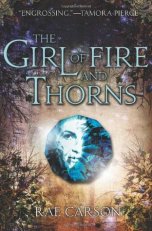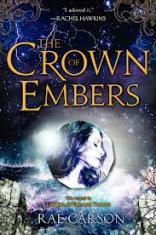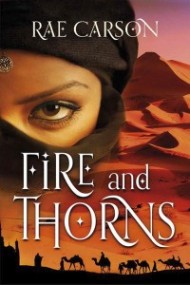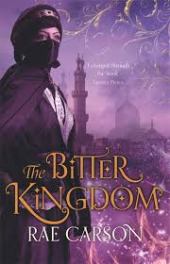This review contains spoilers for A Girl of Fire and Thorns, The Crown of Embers, and The Bitter Kingdom.
Sometime in high school, after reading about yet another vaguely medieval-European fantasy world populated by agile, fair-skinned white people, I decided that, if I ever was to become a writer in the future, I would write a fantasy book in which the protagonist was either a) fat, b) black or darker-skinned, or c) gay. I hadn’t encountered much diversity in fantasy, which seemed to be a genre in love with medieval England and France.
It’s no surprise, then, that when I picked up Rae Carson’s A Girl of Fire and Thorns I was pleasantly surprised to find a strong, intelligent protagonist who was overweight anddark-skinned, living in a tropics-and-desert climate that was a breath of fresh air from the typical mountains-and-pine forest fare.
Let me have my obligatory “Megan-Moans-About-The-State-of-YA-Cover-Art” section first, though. Let’s look at the US and UK cover art for this trilogy:
The woman posing in these photographs is so clearly white that it’s insulting, given that the protagonist Elisa is explicitly described as “dark-skinned” several times throughout the trilogy. Compare these frankly appalling covers to the UK versions:
I don’t know how I feel about her face being covered in all three of these cover photos–in the first one it makes sense since she spends a good deal of time in the desert, but having it covered in all three? That stinks to me of marketing being afraid of showing the full face of someone vaguely Arab-looking on a YA fantasy novel cover, 21st century be damned. That’s problematic, along with the fact that, while definitely more “ethnic” than the US cover art’s cover model, her skin tones seems to have been digitally lightened in these photos. Yikes. However, I love the distinct backgrounds of these covers, as they set the tone and location of each book far better than the US versions.
Okay, enough moaning and groaning about typically racist cover art, because a) What else is new, and b) The writer rarely gets any say on what goes on the cover. The far more important section of this review is what I’m calling
Why You Need to Read This Trilogy Right Now:
1) The main character undergoes substantial and realistic character growth
Elisa begins as a princess moving into a new kingdom, insecure in political marriage she is entering into. She is overweight and fully aware of it, but eats as a coping mechanism (also making this a book that realistically portrays an overweight person). Though smart and wise, she has yet to learn to speak up for herself and find her leadership role. By the end of the first book, she is far healthier (a long trek through the desert will do that to a person), and more confident. She continues to grow through the second and third book in tremendous ways. She copes with death, she makes mistakes (how many protagonists are allowed to really screw up and learn from it?), and she figures out how to disagree with people that she loves and respects. It is very satisfying to see Elisa’s character reach her full potential by the end of The Bitter Kingdom, in which she has blossomed into a courageous leader with conviction, confidence, and enough political savvy to put an end to a major conflict.
2) The magical element in the story is unique and compelling
When I try to describe the magical element in this trilogy, that Elisa is divinely chosen and has a “Godstone” embedded in her stomach, people tend to roll their eyes. It does sound weird, but Carson makes it believable; there is lore behind the bearers of Godstones, there is a religion that tries to make sense of it, and, as religions often do, certain things are wrongly interpreted. Godstones are also a power source, which makes the enemy, a race born with Godstones embedded in them, even more formidable. Elisa learns to harness her Godstone throughout the trilogy, praying and learning to draw energy from the earth to heal or to destroy. What is absolutely phenomenal about this magical plot device, though, is that it doesn’t end up being a deus ex machina at the end of the trilogy. Once Elisa has mastered the use of her Godstone, it seems clear that she will overpower and win through divine force. It is so much satisfying, then, when she loses her Godstone and still manages to solve the main problems through her own power.
3) It has unique things to say about destiny and divine intentions
A typical trope in a fantasy novel is having a character that is destined to do something Great. Whether it’s fulfilling a prophecy or having a birthright, it usually serves as the overall map of the story. This trilogy seems to follow that trope for most of the book, since Elisa is a bearer of the Godstone, which is divinely given to those burdened with a specific task that isn’t usually known until completed. As Elisa’s kingdom falls into threat, it seems clear that her divine mission is to unite the kingdoms and restore peace, but in fact her Godstone falls out after a seemingly insignificant act unrelated to the political turmoil, suggesting that divine will might have very little relation to how many lives you save or how good of a ruler you are. In the end Elisa saves the kingdom because she is strong enough, brave enough, and intelligent enough.
4) It contains a great romantic relationship
It’s always a perk when a well-written fantasy work has a likeable romance that doesn’t overshadow the main plot of the story. At the beginning of the first book, Elisa is engaged to King Alejandro, who is gorgeous and kind, but also an ineffective ruler and uninterested in Elisa. While working with a desert rebellion, Elisa has a budding romance with a young man which isn’t able to last, subverting the “Main woman meets The One immediately and the rest is just inevitable” trope. Her growing friendship and then romance with her royal guard, Hector, however, is where the real meat and potatoes of the romance plot is. From their growing realization of their feelings to their tender and clumsy first time together, the romance feels grounded and realistic, and you can’t help but root for these two characters, who are likeable as individuals and who complement each other well as a couple.
5) It’s exciting!
I can’t overlook the fact that these are, first and foremost, entertaining books. There are plenty of shocks and twists, fascinating world-building, and interesting characters who aren’t what they first appear to be to keep the reader turning pages late into the night.
In short, lovers of YA fantasy should put this on their “To-Read” lists. It is altogether phenomenal.





